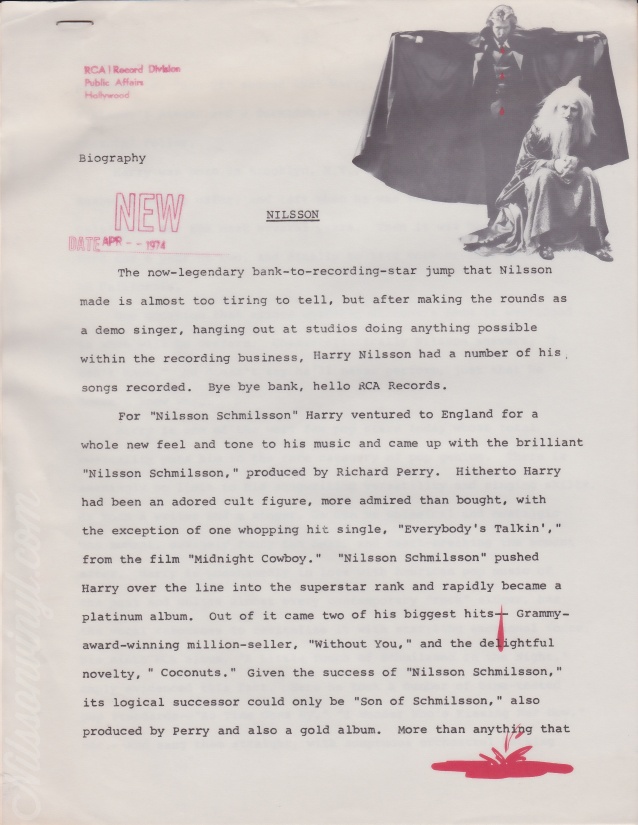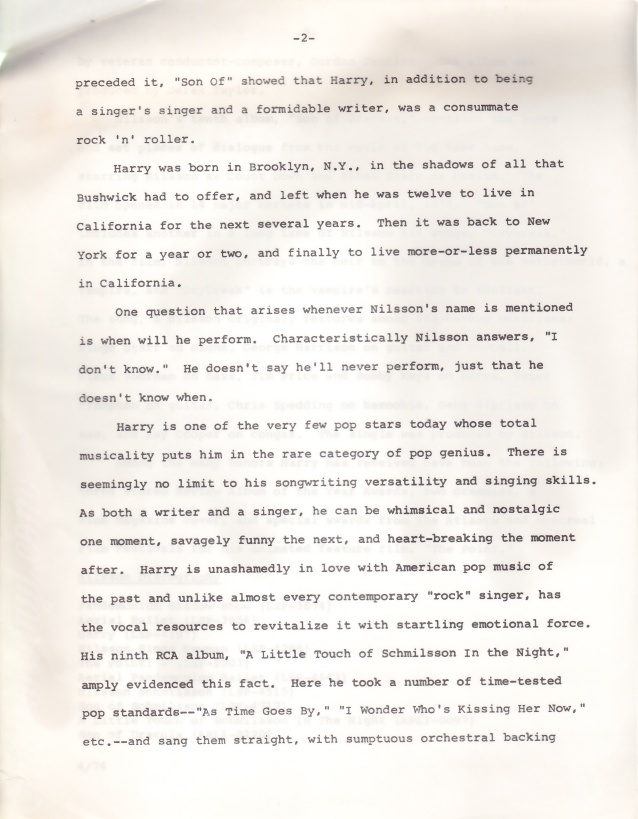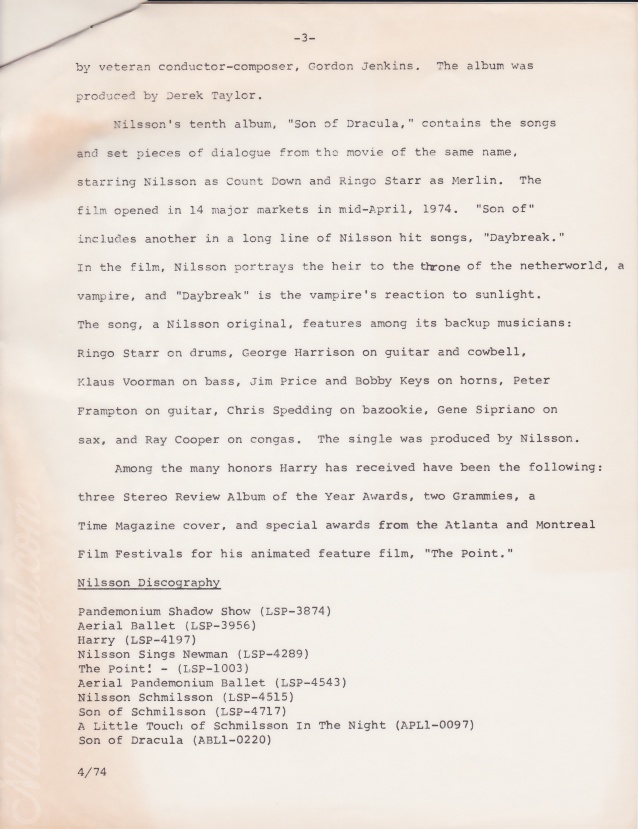From the Public Affairs office of the RCA Record Division comes this April 1974 Press Release of Son of Dracula …



From the Disc and Music Echo (1969), a 28 year old Harry talks about his “current” hit, Everybody’s Talkin‘, writing and performing (or lack thereof) and his upcoming marriage to Diane.
Stumbled across this clipping recently and while I could just make out the article by blowing it up, I thought it would be kinder to my readers if I were to transcribe its contents. You’ll find this below the image …

A Little Touch Of Harry In The Afternoon
The reluctant Harry Nilsson talks to Brian Southall, twice in one week
Being a journalist and meeting Harry Nilsson twice within a week is something special; hearing and seeing him work is something else again.
Harry doesn’t dislike the Press – he just thinks that they can get along quite well without hime. What he’s got to say isn’t really interesting anyway. That’s how he sees it.
So when you’re a Nilsson fanatic like me and you get a chance to hear him cutting some tracks for a new album at studios in London, and maybe even meet the guy, you don’t stand around and think about it.
The scene last Thursday week was Wembley’s CTS studios, just a stone’s throw from the old footie stadium. Harry was down there with producer Derek Taylor and musical director Gordon Jenkins recording an album of old favourites. Songs like Makin’ Whoopee, Always, It Had To Be You, For Me And My Gal, Lazy Moon, I Wonder Who’s Kissing Her Now, What’ll I Do, Nevertheless, This Is All I Ask, Over The Rainbow and As Time Goes By make up the album titled “A Touch Of Schmillson In The Night” due for release sometime in May.
But that was all over and done by Thursday afternoon so Harry and the hand-picked orchestra were laying down six more golden oldies just for the hell of it.
“We did the album in 12 hours,” explained Harry. “And we asked the musicians if they wanted the rest of the time off with pay. They said they were having so much find they wanted to stay. So here we are doing six more. Gordon did a couple more arrangements and we got under way. I really don’t know what we’re going to do with them though.”
The strains of “Lullaby In Ragtime” filter through as Harry and the orchestra start again. The strings are really penetrating and you find yourself humming along. They break, and Nilsson comes back up to the control-room and talks for a bit.
He’s casual in jeans, white RCA T-shirt, suede jerkin with a natty cloth cap on his lengthy blond hair. He enthuses first about Gordon Jenkins, the sliver-haired musical director he’s brought in from America for the album.
“He was there when these were done originally, like ‘Thanks For The Memory’ in 1938 with Bob Hope. I like him and we sent him my albums and he liked them so we got together.
“He began work on the arrangements in December, then he spent six more weeks in Malibu before he got together with me and another pianist to run through the lyrics.”
There’s the little story of the day before when they gave Gordon a present after they’d done one of his songs. “He started crying, his wife cried, I cried and then we were all crying.”
During this break, the 30-or-more-piece orchestra all hand-picked by Jenkins for the job in head, are resting. They sit with their hankies on their chins, but instead of violins they clutch copies of “The Sun” and “Mail”. “It’s the same orchestra for this session as the one we had for the album, except for an oboe player who had to leave to go around the world.”
It’s back to work and they whip through the lovely “Thanks For The Memory” in no time and Harry leaps up again for another Scotch and a pick of his ham salad that’s been lying about all afternoon.
Why had he decided to do the album? “I’ve had the idea for a couple of years, but never had the balls to do it before. Everyone loves these songs and t’s the best and easiest damn session I’ve ever done.
“The lyrics are so good so there’s no problem with singing other people’s songs. There’s nothing about now in this vein and there’s no end to the albums you can do. Things like a Christmas album, kids album. God’s album-there’s no end to it.
“No matter what we look like or how we dress, we still come back to great songs theres. I mean, we want “Yesterday” to hang around for 900 years, and these are even older and are still about. In actual fact, Ringo started it all with his “Sentimental Journey” album. He was the first to do it.”
Harry then briefly got dragged into the recent “Three Beatles and Nilsson to record” rumours. Is there any truth in the tale? “John and George are in Los Angeles to do some stuff for Ringo, who’s emerged with a whole new voice. John and George have written a track each. I’m keeping all the cutting talking about me and the three Beatles so I can show my grand-children.”
Harry explains that one of the reasons he was attracted by these standards is because they get people to dance together. He says he’s fed up with all the current leaping and tells how a few nights back he got drunk and found himself dancing in a club.
New dance
“All these people were swaying around and suddenly I just leapt into the air and invented the “Kangaroo” He demonstrates with giant leaps into the air.
Back to work, and into “Trust In Me” with choppy bass lines. It’s take 90 and there’s a bit of humorous chit-chat between Harry and his amiable producer Derek Taylor.
“Can we have a little less bawdiness and little more music,” says the professional Jenkins.
They move on to “Make Believe” and a little bit more fun and Harry shouts through the intercom: “In politics, the Left wing should never know what the Right’s doing”.
“You should have been a writer,” says Jenkins.
Back comes Harry: “Send down some more Scotch and acid”.
“Want some horse” jokes Taylor and Harry grunts: “Right.”
Then they break for a few hours and I’m away, treasuring my verbal invite to the BBC studios for a TV special of the album being done last Wednesday.
It takes a few phone calls to fix it up and convince the “Beeb” that Harry and their own famed “In Concert” producer Stanley Doorman did invite me. But my name’s on the door, and I’m in.
The same orchestra is there and Gordon Jenkins is there in the same pale blue sweat-shirt and a shade darker slacks. He takes then through the numbers while the ashtrays are emptied by a courteous and highly-efficient cleaner.
Harry appears and he’s a good bit neater for his TV appearance. There’s a black shirt, white trousers, black and white plimsolls, and the mop of hair’s freshly washed and fluffy.
The basic set is completed with the introduction of a low wooden dais for Jenkins to stand on, the removal of a few blue-painted boards and the dimming of the bright lights.
It’s time for a take and the technicians scramble to get the best earphones out of an old cardboard box. Cameras zoom about like Daleks, the largest mobile crane camera gets carried away and collides with the studio gallery.
Harry’s gone and come back again, marking his entrance this time with a swift bash on the drums with the brushes. They run through the first side of the album without a break and when it comes to the chorus-line in “It Had To Be You,” Harry looks admiringly and sings at Jenkins on his rostrum. The talented 60-year-old replies with a quick soft-shoe-shuffle.
one run-through finished, and Harry’s fair has got to be done again. “Its about time you combed it,” says Jenkins.
“Which one” says Harry.
“All of it,” quips Gordon.
Back he comes and they run through the first side all over again. Harry’s voice is very faint to us int he theatre seats, but the orchestra are in full flight with the swirling strings and the gentle floating quality of the flutes and harp.
Jenkins’ arrangements are perfection. there’s a story-line throughout the album with the dozen actual songs being linked with the theme from more famous old standards. The themes spell out the meeting of a boy and girl, their marriage, children and eventual break-up. The songs do the same.
But it’s the way things like the theme from “Over the Rainbow” blends in so perfectly with “Always” or “As Time Goes By” introduces “Makin’ Whoopee.”
Harry says after this second take: “It’s all down to Gordon. He’s done a superb job.” Harry wonders whether we can hear all right in the audience. I tell him his vocals are a bit faint and he explains that they can’t switch the PA on it it’ll drown the orchestra.
Up at the drums is the young daughter of Derek Taylor and Nilsson’s setting her a rhythm and banging away with the sticks himself.
“I’m really a frustrated drummer you know. Sometimes Ringo and I just stand at the drums with a pair of sticks each and really get it going. He’s the best there is – him and Jim Keltner.”
And that’s it. There’s a break called for a couple of hours before they get down to doing side two of the album, and Nilsson’s left in the studio discussing things with Taylor and Jenkins. A picture of the three men who deserve great credit for this very fine work of musicianship.
At last it’s here! The February 2016 issue of Record Collector magazine contains a feature I wrote on rare Harry Nilsson vinyl. The original plan was for a four page spread but was eventually reduced to three pages. As a consequence some key images were edited out which is unfortunate but overall I’m quite pleased with how it came out.

At one stage I’d suggested that Harry would be perfect for the cover (even going so far as to supply cover art) but alas, it’s a photo of wild-eyed Ozzy that beckons the Nilsson fan to pick up a copy. My sincere hope is that all Nilsson fans will do just that and in turn, reach out the magazine @RecCollMag and let them know WE WANT MORE NILSSON!